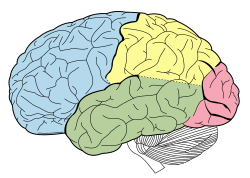Temporal lobe facts for kids
| Brain: Temporal lobe | ||
|---|---|---|
Quick facts for kids [[Image:
|250px|center|]]
|
||
| Lobes of the human brain (temporal lobe is shown in green) | ||
| Section of brain showing upper surface of temporal lobe. | ||
| Latin | Lobus temporalis | |
| Part of | Cerebrum | |
| Artery |
|
|
| Vein |
|
|
The temporal lobe is one of the four main parts, or "lobes," of your brain. It's found in the cerebral cortex, which is the outer layer of your brain. This important part of the brain sits right behind your temples, near your ears.
The temporal lobe helps you understand what you see and hear. It's also key for remembering things, especially visual memories, understanding language, and connecting feelings to experiences. The word "temporal" comes from the word "temple," which is the side of your head.
Contents
What the Temporal Lobe Does
The temporal lobe is like a busy control center. It helps with many important jobs, from hearing sounds to remembering faces.
Processing Senses
Your temporal lobe takes in information from your senses and makes sense of it.
Hearing and Sounds
The temporal lobe is very important for hearing. It has a special area called the primary auditory cortex. This area gets sound information from your ears. Other parts of the temporal lobe then help you understand what those sounds mean, like recognizing speech or music.
Seeing and Understanding
This part of your brain also helps you understand what you see. It helps you recognize objects and even faces. For example, a part called the fusiform gyrus helps you recognize people's faces. Another part, the parahippocampal gyrus, helps you understand scenes you see.
Understanding Language
The temporal lobe is super important for language. It helps you understand both spoken and signed language.
A key area called Wernicke's area is located here. It works with another area called Broca's area (in the frontal lobe) to help you understand words and sentences. When you hear someone speak or watch someone sign, these parts of your brain become active. This is true for kids learning language too!
The left temporal lobe does more than just hear sounds. It helps with understanding, naming things, and remembering words.
Making New Memories
The temporal lobe plays a big role in forming new memories, especially declarative memories. These are memories you can consciously recall, like facts or events.
Inside the temporal lobe are structures like the hippocampus. The hippocampus is essential for making new memories. If this area is damaged, it can be hard to form new memories, which is called anterograde amnesia.
What Happens if the Temporal Lobe is Damaged
If the temporal lobe gets damaged, it can cause problems with how you understand the world around you.
One common issue is visual agnosia. This means a person can see objects but has trouble recognizing what they are. For example, they might see a spoon but not know it's a spoon.
Another problem can be prosopagnosia, which is when someone has trouble recognizing faces, even familiar ones.
Sometimes, damage to the front part of the left temporal lobe can lead to savant syndrome. This is a rare condition where a person has amazing abilities in certain areas, like math or music, but might struggle in other areas.
Conditions Related to the Temporal Lobe
Some health conditions are linked to problems in the temporal lobe.
Pick's Disease
Pick's disease is a condition where parts of the front and temporal lobes shrink. This can cause changes in mood, like being easily distracted or acting aggressively. It can also affect language, making it hard to speak, read, or write.
Temporal Lobe Epilepsy
Temporal lobe epilepsy is a brain condition that causes repeated seizures. During these seizures, a person might experience strange sensations, like seeing or hearing things that aren't there. They might also have trouble processing memories.
Schizophrenia
Schizophrenia is a serious mental disorder that can cause a person to feel confused or disoriented. A common symptom is hearing voices that aren't real. Scientists believe this might be due to problems in the left temporal lobe, especially in the area that processes sounds.
Images for kids
See also
 In Spanish: Lóbulo temporal para niños
In Spanish: Lóbulo temporal para niños






